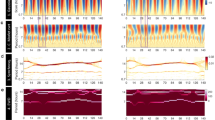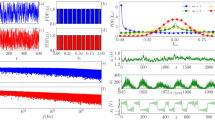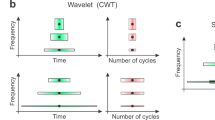Abstract
We present a new approach to exoplanet characterization using techniques from complexity science, with potential applications to biosignature detection. This agnostic method makes use of the temporal variability of light reflected or emitted from a planet. We use a technique known as epsilon machine reconstruction to compute the statistical complexity, a measure of the minimal model size for time series data. We demonstrate that statistical complexity is an effective measure of the complexity of planetary features. Increasing levels of qualitative planetary complexity correlate with increases in statistical complexity and Shannon entropy, demonstrating that our approach can identify planets with the richest dynamics. We also compare Earth time series with Jupiter data, and find that for the three wavelengths considered Earth’s average complexity and entropy rate are approximately 50% and 43% higher than Jupiter’s, respectively. The majority of schemes for the detection of extraterrestrial life rely upon biochemical signatures and planetary context. However, it is increasingly recognized that extraterrestrial life could be very different from life on Earth. Under the hypothesis that there is a correlation between the presence of a biosphere and observable planetary complexity, our technique offers an agnostic and quantitative method for the measurement thereof.
This is a preview of subscription content, access via your institution
Access options
Access Nature and 54 other Nature Portfolio journals
Get Nature+, our best-value online-access subscription
$29.99 / 30 days
cancel any time
Subscribe to this journal
Receive 12 digital issues and online access to articles
$119.00 per year
only $9.92 per issue
Buy this article
- Purchase on Springer Link
- Instant access to full article PDF
Prices may be subject to local taxes which are calculated during checkout


Similar content being viewed by others
Data availability
Source data for all time series as well as the data points in the figures in the main text are provided with this paper.
Code availability
C++ code for the EMR process used in this study can be accessed here: https://nicolas.brodu.net/recherche/decisional_states/index.html.
References
Kiang, N. Y. et al. Exoplanet biosignatures: at the dawn of a new era of planetary observations. Astrobiology 18, 619–629 (2018).
Meadows, V. S. et al. Exoplanet biosignatures: understanding oxygen as a biosignature in the context of its environment. Astrobiology 18, 630–662 (2018).
Bartlett, S. & Wong, M. L. Defining lyfe in the universe: from three privileged functions to four pillars. Life 10, 42 (2020).
Dorn, E. D., Nealson, K. H. & Adami, C. Monomer abundance distribution patterns as a universal biosignature: examples from terrestrial and digital life. J. Mol. Evol. 72, 283–295 (2011).
Guttenberg, N., Chen, H., Mochizuki, T. & Cleaves, H. J. Classification of the biogenicity of complex organic mixtures for the detection of extraterrestrial life. Life 11, 234 (2021).
Johnson, S. S., Anslyn, E. V., Graham, H. V., Mahaffy, P. R. & Ellington, A. D. Fingerprinting non-terran biosignatures. Astrobiology 18, 915–922 (2018).
Krissansen-Totton, J., Bergsman, D. S. & Catling, D. C. On detecting biospheres from chemical thermodynamic disequilibrium in planetary atmospheres. Astrobiology 16, 39–67 (2016).
Krissansen-Totton, J., Olson, S. & Catling, D. C. Disequilibrium biosignatures over earth history and implications for detecting exoplanet life. Sci. Adv. 4, eaao5747 (2018).
Marshall, S. M. et al. Identifying molecules as biosignatures with assembly theory and mass spectrometry. Nat. Commun. 12, 3033 (2021).
Solé, R. V. & Munteanu, A. The large-scale organization of chemical reaction networks in astrophysics. Europhys. Lett. 68, 170 (2004).
Walker, S. I. et al. Exoplanet biosignatures: future directions. Astrobiology 18, 779–824 (2018).
Marshak, A. et al. Earth observations from DSCOVR EPIC instrument. Bull. Am. Meteorol. Soc. 99, 1829–1850 (2018).
Fan, S. et al. Earth as an exoplanet: a two-dimensional alien map. Astrophys. J. Lett. 882, L1 (2019).
Gu, L. et al. Earth as a proxy exoplanet: deconstructing and reconstructing spectrophotometric light curves. Astron. J. 161, 122 (2021).
Jiang, J. H. et al. Using Deep Space Climate Observatory measurements to study the earth as an exoplanet. Astron. J. 156, 26 (2018).
Baluška, F. & Levin, M. On having no head: cognition throughout biological systems. Front. Psychol. 7, 902 (2016).
Davies, P. C. & Walker, S. I. The hidden simplicity of biology. Rep. Prog. Phys. 79, 102601 (2016).
Farnsworth, K. D., Nelson, J. & Gershenson, C. Living is information processing: from molecules to global systems. Acta Biotheor. 61, 203–222 (2013).
Tkačik, G. & Bialek, W. Information processing in living systems. Annu. Rev. Condens. Matter Phys. 7, 89–117 (2016).
Walker, S. I., Kim, H. & Davies, P. C. The informational architecture of the cell. Phil. Trans. R. Soc. A 374, 20150057 (2016).
Witzany, G. What is life? Front. Astron. Space Sci. 7, 7 (2020).
Brodu, N. & Crutchfield, J. P. Discovering causal structure with reproducing-kernel Hilbert space ϵ-machines. Preprint at https://arxiv.org/abs/2011.14821 (2020).
Marzen, S. & Crutchfield, J. P. Informational and causal architecture of continuous-time renewal processes. J. Stat. Phys. 168, 109–127 (2017).
Sinapayen, L. & Ikegami, T. Online fitting of computational cost to environmental complexity: predictive coding with the ε-network. Artif. Life Conf. Proc. 14, 380–387 (2017).
Shannon, C. E. A mathematical theory of communication. Bell Syst. Tech. J. 27, 379–423 (1948).
Crutchfield, J. P. Between order and chaos. Nat. Phys. 8, 17–24 (2012).
Feldman, D. P., McTague, C. S. & Crutchfield, J. P. The organization of intrinsic computation: complexity–entropy diagrams and the diversity of natural information processing. Chaos 18, 043106 (2008).
Bak, P. How Nature Works: the Science of Self-Organized Criticality (Springer, 2013).
Kauffman, S. At Home in the Universe: the Search for the Laws of Self-Organization and Complexity (Oxford Univ. Press, 1996).
Langton, C. G. Computation at the edge of chaos: phase transitions and emergent computation. Physica D 42, 12–37 (1990).
Catling, D. C. et al. Exoplanet biosignatures: a framework for their assessment. Astrobiology 18, 709–738 (2018).
Pierrehumbert, R. T. & Hammond, M. Atmospheric circulation of tide-locked exoplanets. Annu. Rev. Fluid Mech. 51, 275–303 (2019).
Smith, E. & Morowitz, H. J. The Origin and Nature of Life on Earth: the Emergence of the Fourth Geosphere (Cambridge Univ. Press, 2016).
Chopra, A. & Lineweaver, C. H. The case for a Gaian bottleneck: the biology of habitability. Astrobiology 16, 7–22 (2016).
Lenardic, A. & Seales, J. Habitability: a process versus a state variable framework with observational tests and theoretical implications. Int. J. Astrobiol. 20, 125–132 (2021).
Lenton, T. M. et al. Selection for Gaia across multiple scales. Trends Ecol. Evol. 33, 633–645 (2018).
Nicholson, A. E., Wilkinson, D. M., Williams, H. T. & Lenton, T. M. Gaian bottlenecks and planetary habitability maintained by evolving model biospheres: the ExoGaia model. Mon. Not. R. Astron. Soc. 477, 727–740 (2018).
Kasting, J. F. & Siefert, J. L. Life and the evolution of Earth’s atmosphere. Science 296, 1066–1068 (2002).
Dyke, J., Gans, F. & Kleidon, A. Towards understanding how surface life can affect interior geological processes: a non-equilibrium thermodynamics approach. Earth Syst. Dyn. 2, 139–160 (2011).
Li, K.-F., Pahlevan, K., Kirschvink, J. L. & Yung, Y. L. Atmospheric pressure as a natural climate regulator for a terrestrial planet with a biosphere. Proc. Natl Acad. Sci. USA. 106, 9576–9579 (2009).
Harvey, I. The circular logic of Gaia: fragility and fallacies, regulation and proofs. Eur. Conf. Artif. Life Proc. 13, 90–97 (2015).
Wood, A. J., Ackland, G. J., Dyke, J. G., Williams, H. T. & Lenton, T. M. Daisyworld: a review. Rev. Geophys. 46, RG1001 (2008).
West, G. B. Scale: the Universal Laws of Growth, Innovation, Sustainability, and the Pace of Life in Organisms, Cities, Economies, and Companies (Penguin, 2017).
Galas, D. J., Sakhanenko, N. A., Skupin, A. & Ignac, T. Describing the complexity of systems: multivariable ‘set complexity’ and the information basis of systems biology. J. Comput. Biol. 21, 118–140 (2014).
Marzen, S. E. & Crutchfield, J. P. Structure and randomness of continuous-time, discrete-event processes. J. Stat. Phys. 169, 303–315 (2017).
Bertello, G., Arduin, P.-J., Boschetti, F. & Weatherley, D. Application of computational mechanics to the analysis of seismic time-series via numerical optimisation. New Gener. Comput. 27, 1–23 (2008).
Marzen, S. Intrinsic computation of a Monod–Wyman–Changeux molecule. Entropy 20, 599 (2018).
Muñoz, R. N. et al. General anesthesia reduces complexity and temporal asymmetry of the informational structures derived from neural recordings in Drosophila. Phys. Rev. Res. 2, 023219 (2020).
Park, J. B., Lee, J. W., Yang, J.-S., Jo, H.-H. & Moon, H.-T. Complexity analysis of the stock market. Physica A 379, 179–187 (2007).
Varn, D. P. & Crutchfield, J. P. Chaotic crystallography: how the physics of information reveals structural order in materials. Curr. Opin. Chem. Eng. 7, 47–56 (2015).
Adami, C., Ofria, C. & Collier, T. C. Evolution of biological complexity. Proc. Natl Acad. Sci. USA 97, 4463–4468 (2000).
Lineweaver, C. H., Davies, P. C. & Ruse, M. Complexity and the Arrow of Time (Cambridge Univ. Press, 2013).
Smith, J. M. & Szathmary, E. The Major Transitions in Evolution (Oxford Univ. Press, 1997).
Adami, C. What is complexity? BioEssays 24, 1085–1094 (2002).
Gell-Mann, M. & Lloyd, S. Information measures, effective complexity, and total information. Complexity 2, 44–52 (1996).
Wolpert, D. H. & Macready, W. Using self-dissimilarity to quantify complexity. Complexity 12, 77–85 (2007).
Chaitin, G. J. Information, Randomness & Incompleteness: Papers on Algorithmic Information Theory Vol. 8 (World Scientific, 1990).
Kolmogorov, A. N. On tables of random numbers. Sankhyā A 25, 369–376 (1963).
Packard, N. H., Crutchfield, J. P., Farmer, J. D. & Shaw, R. S. Geometry from a time series. Phys. Rev. Lett. 45, 712 (1980).
Shalizi, C. R. & Crutchfield, J. P. Computational mechanics: pattern and prediction, structure and simplicity. J. Stat. Phys. 104, 817–879 (2001).
Crutchfield, J., Farmer, J., Packard, N. & Shaw, R. Chaos. Sci. Am. 225, 46–57 (1986).
Brodu, N. Reconstruction of epsilon-machines in predictive frameworks and decisional states. Adv. Complex Syst. 14, 761–794 (2011).
Lane, N. Oxygen: the Molecule that Made the World (Oxford Univ. Press, 2002).
Olejarz, J., Iwasa, Y., Knoll, A. H. & Nowak, M. A. The Great Oxygenation Event as a consequence of ecological dynamics modulated by planetary change. Nat. Commun. 12, 3985 (2021).
Acknowledgements
We acknowledge partial funding support from the NASA Exoplanet Research Program NNH18ZDA001N-2XRP. A portion of this research was carried out at the Jet Propulsion Laboratory, California Institute of Technology, under a contract with NASA (80NM0018D0004). Y.L.Y. was supported in part by an NAI Virtual Planetary Laboratory grant from the University of Washington. We thank the members of the Caltech GPS ‘Astrobiothermoevoinfo’ reading group for the various inspiring discussions that have helped catalyse ideas such as those presented here. We also thank T. Ewald at Caltech for valuable help with the processing of Jupiter data from Cassini. Finally, S.B. thanks S. Bullock for being his guide into the world of complexity.
Author information
Authors and Affiliations
Contributions
S.B. conceived of the idea of using EMR to analyse planetary complexity and the hypothesized correlation between planetary complexity and the presence of life. He performed the complexity analysis, produced the figures and wrote the manuscript. J.L. provided the Jupiter Cassini data. L.G. and S.F. produced the synthetic Earth and recomposed datasets. L.S. assisted with the complexity analysis, results interpretation, literature review and manuscript editing. V.N. assisted with results interpretation and manuscript editing. J.H.J., D.C. and Y.L.Y. provided essential guidance, assistance with data provision, results interpretation and manuscript editing.
Corresponding author
Ethics declarations
Competing interests
The authors declare no competing interests.
Peer review
Peer review information
Nature Astronomy thanks Cole Mathis and the other, anonymous, reviewer(s) for their contribution to the peer review of this work
Additional information
Publisher’s note Springer Nature remains neutral with regard to jurisdictional claims in published maps and institutional affiliations.
Extended data
Extended Data Fig. 1 Epsilon machine example.
A simple epsilon machine with a set of discrete states (blue circles), a start state (double circle on the left), a set of state-to-state transitions (orange arrows), and a set of measurement observables for each transition (green numbers). Each transition has a certain probability of occurrence (not shown in the diagram). The Shannon entropy measures the intrinsic randomness of the model (technically the state probability-weighted information content of the transition probability distributions). The statistical complexity measures the information content of the state space of the model. Notation follows that of26.
Extended Data Fig. 2 Time series processing.
Examples showing the pre-processing of time series in preparation for EMR. a) Original, unaltered time series from the 10 reflectance channels, b) Original time series after normalization and discretization, c) Synthetic time series generated by replacing all pixels with a characteristic desert spectrum, d) Normalized and discretized versions of the series in (c).
Extended Data Fig. 3 Earth, Jupiter time series.
Time series for Earth (blue, 443nm wavelength) and Jupiter (red, 450.9nm wavelength) used for the complexity comparison.
Extended Data Fig. 4 Earth, Jupiter complexity comparison.
Statistical complexities of Earth and Jupiter time series in three wavelength bands for a range of kernel width parameter values.
Supplementary information
Supplementary Information
Supplementary Figs. 1–5, Tables 1 and 2 and Sections 1–4.
Source data
Source Data Fig. 1
Data points for Fig. 1.
Source Data Fig. 2
Data points for Fig. 2.
Rights and permissions
About this article
Cite this article
Bartlett, S., Li, J., Gu, L. et al. Assessing planetary complexity and potential agnostic biosignatures using epsilon machines. Nat Astron 6, 387–392 (2022). https://doi.org/10.1038/s41550-021-01559-x
Received:
Accepted:
Published:
Issue Date:
DOI: https://doi.org/10.1038/s41550-021-01559-x
This article is cited by
-
Using artificial intelligence to transform astrobiology
Nature Astronomy (2023)
-
Understanding planetary context to enable life detection on exoplanets and test the Copernican principle
Nature Astronomy (2022)



